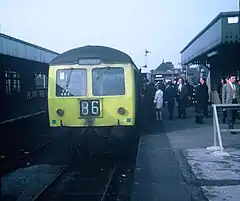British Rail Classes 112 and 113
The Class 112 and Class 113 DMUs used the standard Cravens body used on Class 105s but had a single Rolls-Royce C8NFLH engine rated at 238 hp (177 kW) per car, all of which formed into 'power twins' – two car sets with both vehicles powered.
| British Rail Classes 112 and 113 | |
|---|---|
 Last train from Nottingham Arkwright Street, 1969 | |
| In service | 1960–1969 |
| Manufacturer | Cravens |
| Family name | First generation |
| Replaced | Steam locomotives and carriages |
| Constructed | 1959–1960 |
| Scrapped | 1968–1969 |
| Number built | Class 112: 25 sets (50 cars) Class 113: 25 sets (50 cars) |
| Number scrapped | All |
| Formation | Power-twin: DMBS-DMCL |
| Capacity | DMBS: 52 second DMCL: 12 first, 51 second |
| Operator(s) | British Rail |
| Line(s) served | London Midland Region |
| Specifications | |
| Car body construction | Steel |
| Car length | 57 ft 6 in (17.53 m) |
| Width | 9 ft 3 in (2.82 m) |
| Doors | Slam |
| Maximum speed | 70 mph (110 km/h) |
| Weight | DMBS: 30 long tons 0 cwt (67,200 lb or 30.5 t), DMCL: 30 long tons 0 cwt (67,200 lb or 30.5 t) |
| Prime mover(s) | One Rolls-Royce C8NFLH |
| Power output | 238 hp (177 kW) per car |
| Transmission | Class 112: Mechanical 4-speed epicyclic gearbox Class 113: Hydraulic |
| UIC classification | (1A)(A1)+(1A)(A1) |
| Braking system(s) | Vacuum |
| Coupling system | Screw-link |
| Multiple working | ■ Blue Square |
| Track gauge | 4 ft 8+1⁄2 in (1,435 mm) |
There were two batches built, the first 50 vehicles (25 sets) had standard mechanical transmission via a gearbox and were allocated the Class 112. The second batch of 50 cars (25 sets) had hydraulic transmissions, and became Class 113s.
The cars were built for services in the LMR Central Division and in the Liverpool - St Helens area, where the gradients in the Lancashire & Yorkshire area required more power. Both types also spent some time working from Cricklewood.
The gross weight of a set with all seats occupied was approximately 70 tons, giving 6.8 hp (5.1 kW) per ton. Empty, it was 8.1 hp/ton, which compared favourably with 5.7 hp/ton that the Cravens power/trailer had.
In 1982,[1] two units, M51692 and M51691, were in use by British Steel at Shotton Works on Deeside.
Orders
| Lot No. | Diagram | Car Type | Qty | Fleet numbers | Notes |
|---|---|---|---|---|---|
| 30533 | 602 | Driving Motor Brake Third (DMBS) | 25 | 51681–51705 | Class 112 |
| 30534 | 603 | Driving Motor Composite with lavatory (DMCL) | 25 | 51706–51730 | Class 112 |
| 30535 | 604 | Driving Motor Brake Third (DMBS) | 25 | 51731–51755 | Class 113 |
| 30536 | 605 | Driving Motor Composite with lavatory (DMCL) | 25 | 51756–51780 | Class 113 |
Other technical details
- Coupling Code: Blue Square
- Transmission: Standard Mechanical (Class 112), Hydraulic (Class 113)
Due to incidents that occurred when Class 113 units (which had hydraulic transmission and automatic gear change) were coupled to a unit with mechanical transmission and gear change - usually, a Class 112 - the Class 113 units were changed to the Red Triangle coupling code (the Red Triangle code had previously been used for the early Derby Lightweight DMUs used in the Leeds area, but those were all now withdrawn). The basic problem occurred when a unit being driven automatically (Class 113) failed to mesh with a unit that could not be driven automatically (most Blue Square types). The latter units tended to catch fire. If such a pairing occurred, the driver of the automatically driven unit was supposed to drive it as if it were a mechanical transmission unit, so the two units gears would work together.
If an automatic transmission unit was driven from a mechanical transmission unit the problem did not occur, as the automatic drive unit would change gears as if it was a mechanical drive unit. The Class 112 and 113 units looked similar and one assumes this led to the driving errors. By changing Class 113 to Red Triangle, the incompatible coupling should not occur.
Withdrawal
All Class 112s and 113s were withdrawn and subsequently scrapped between 1968 and 1969.
References
- Industrial Locomotives 1982 including preserved and minor railway locomotives. Industrial Railway Society. 1982. p. 209. ISBN 0 901096 43 1.
- The Railcar Association
- Motive Power Recognition: 3 DMUs. Colin J. Marsden
- British Railway Pictorial: First Generation DMUs. Kevin Robertson
- British Rail Fleet Survey 8: Diesel Multiple Units- The First Generation. Brian Haresnape
- A Pictorial Record of British Railways Diesel Multiple Units. Brian Golding